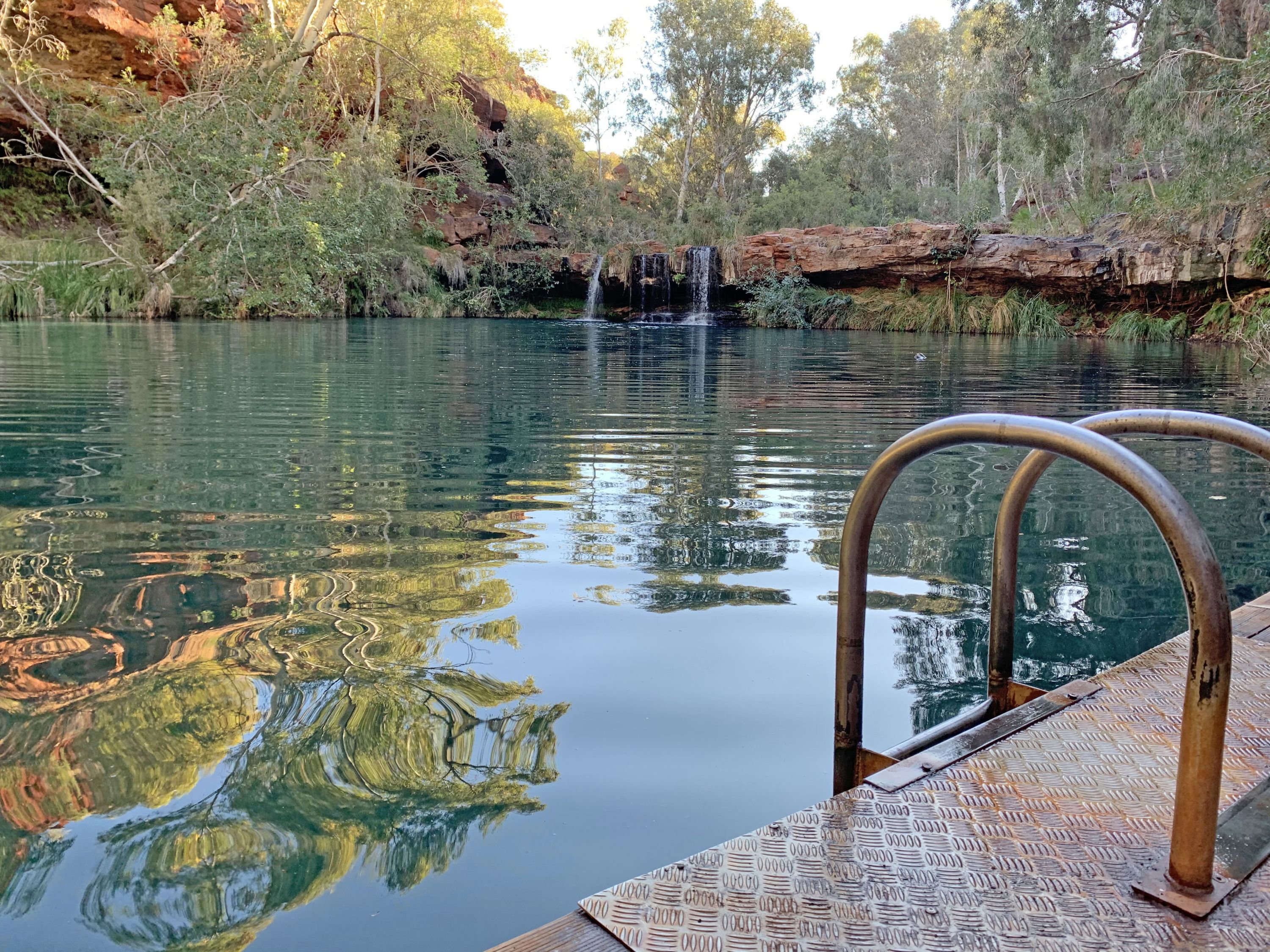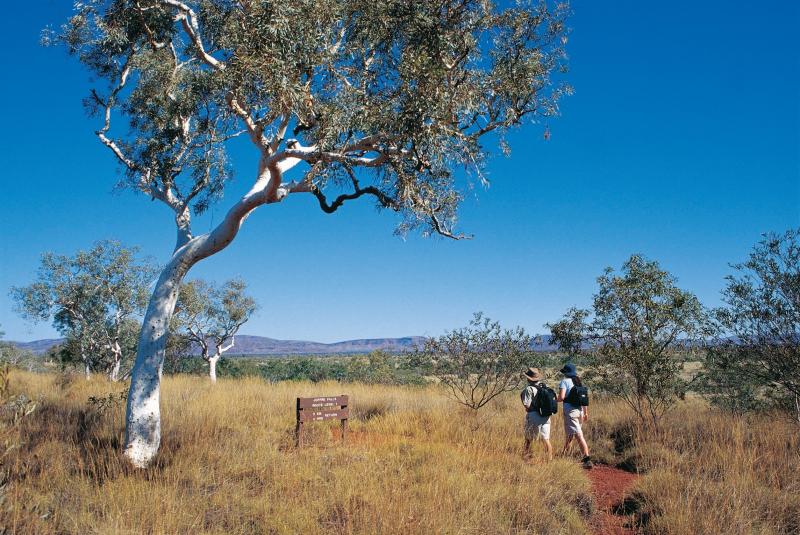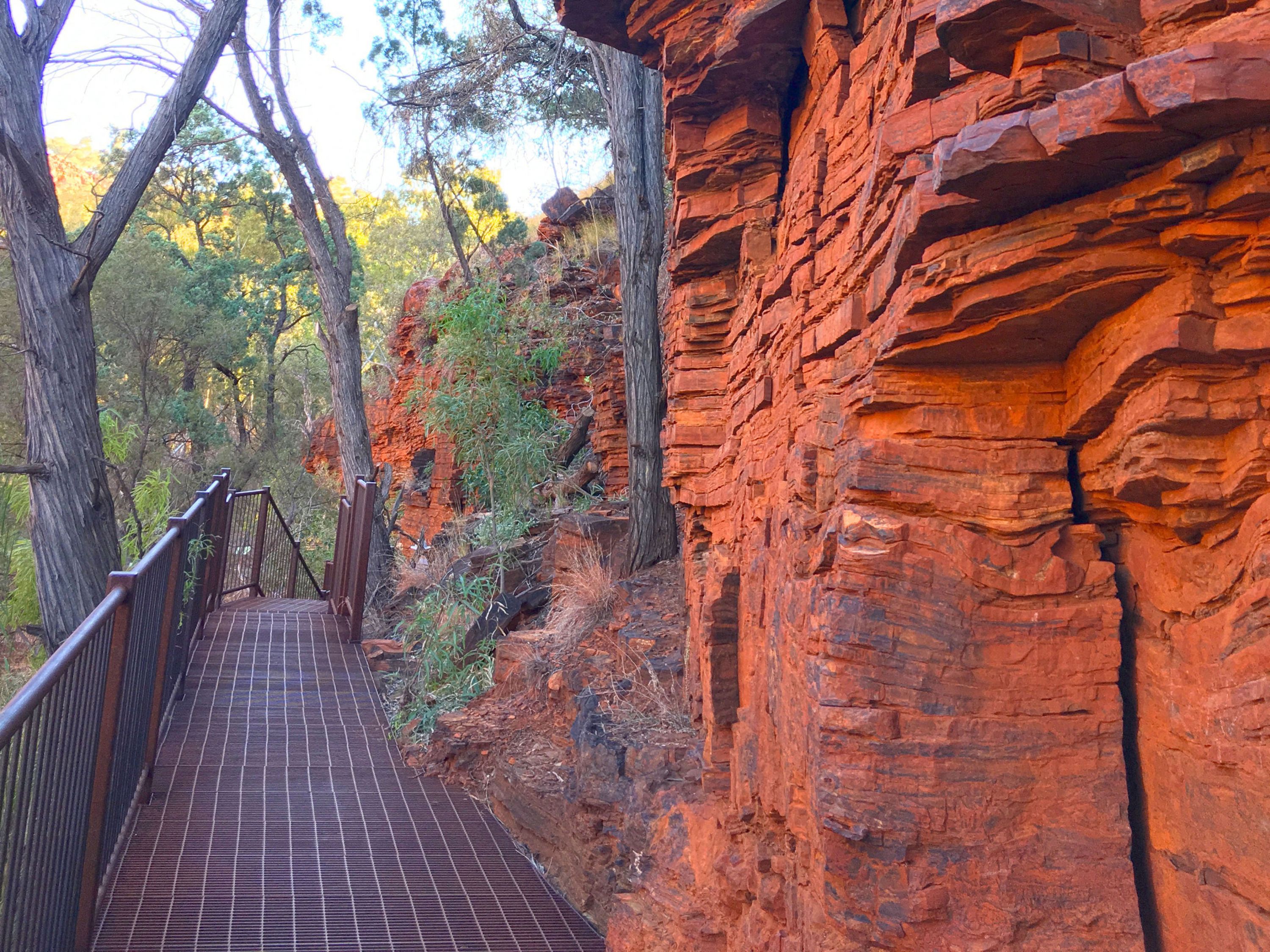About Karijini National Park



An Iconic Destination
The Ancient Pilbara Region of Western Australia
Karijini National Park is an iconic, unspoiled nature-based destination. Filled with unique and diverse landscapes, a visit here is an unforgettable outback experience.
Located 1,500km north of Perth and around 80km north-east of Tom Price, Karijini (formerly Hamersley Range) National Park is the second largest national park in Western Australia covering 627,422 hectares and is ranked in the top 5 visitor experiences for the state.
Karijini is famous for its spectacular gorges and slot canyons, towering sheer sided chasms up to 100 metres deep, dramatic waterfalls, rocky creeks, refreshing waterholes and colours ranging from pindan red-orange to deep blue-purple rocks and jade green water.
This is an ancient part of the planet. Standing deep inside a gorge, you'll feel like you've taken a journey back in time, to the centre of the earth. Billions of years in the making, the slow process of erosion has carved the shape of the land out of rocks that are over 2.5 billion years old to form this intriguing landscape and complex ecology.
Karijini's climate can best be described as tropical semi-desert. A highly variable, mainly summer rainfall of 250“350mm, often associated with thunderstorms and cyclones, is accompanied by temperatures frequently topping 40°C. The ideal times to visit are late autumn, winter and early spring. Winter days are warm and clear, but nights are cold and sometimes frosty.
A party led by explorer F.T. Gregory explored the area in 1861. He named the Hamersley Range, on which the National Park is centred, after his good friend Edward Hamersley. The Traditional Owners and original custodians of this land gave the Banjima name for this range as Karijini, and so the National Park was officially renamed.
Traditional Owners
Karijini NP is the traditional home of the Banyjima, Kurrama and Innawonga Aboriginal people. The Banjima name for the Hamersley Range is Karijini. The name of the Park recognises the historic and continuing significance of the area to the people and their involvement in park management. Evidence of their ancestors occupation dates back more than 30,000 years. During that period, Aboriginal land management practices such as 'fire stick farming', resulting in a diversity of vegetation types and stages of succession, have helped determine the nature of the plants and animals found in the Park today.
Fern Pool and Circular Pool are among many sacred and special places to Aboriginal people. In Aboriginal Dreamtime stories, a giant serpent created these pools in a time when the earth was soft, and the spirit is believed to still live in these waters. You will feel a special, tranquil energy in these places and the cool water is perfect to swim in after a day of hiking the gorges. To protect the heritage, cultural and environmental values of these areas, visitors are encouraged to be respecful, enter the water quietly and avoid making loud noises. Access to the area above Fern Pool is not permitted. Please do not climb or jump from this waterfall or from the ledges surrounding Circular Pool.
Wildflowers & Wildlife
Karijini National Park protects many different wildlife habitats, landscapes, plants and animals of the Pilbara region.
Wildflowers vary with the seasons. In the cooler months, the land is covered with yellow-flowering cassias and wattles, northern bluebells and purple mulla-mullas. After rain, many plants bloom profusely, blanketing the ground. White-barked snappy gum trees famously contrast with Karijini's red earth. The vegetation ranges from spinifex hummocks, acacias, eucalypts, melaleucas and low mulga woodlands, to fern-lined rock pools and fig trees clinging to cliff walls.
Huge termite mounds are a feature of the landscape along with the rock piles of the rare native Western pebble-mound mouse, found only in the Pilbara region. Karijini NP is also home to a variety of birds, red kangaroos, euros, rock-wallabies, echidnas, dingoes and several bat species. Frogs, geckos, goannas, dragons, legless lizards, pythons and other snakes are abundant. Native marsupials such as the endangered northern quoll and Pilbara ningaui are resident, but nocturnal and shy.
Formation of the Land
Rocks exposed at the gorges originated as fine-grained sediment which accumulated on an ancient sea floor over 2.5 billion years ago. At this time, the atmosphere contained much less oxygen and the only forms of life were simple bacteria and algae. Many of these sediments laid down in the oceans were rich in iron and silica.
Over hundreds of millions of years, the iron-rich deposits were transformed by the pressure of further sediments laid down over them, and they gradually turned into tough well-bedded rock. The gorges were eroded when a sharp drop in sea level caused the rivers to downcut rapidly - a process enhanced by the onset of a more arid climate, which depleted the protective vegetation cover on the valley sides.
In Dales Gorge, a stream, pools, waterfalls and ferns contrast with the red, terraced cliffs weathered by centuries of exposure. The occasional snappy gum can be seen clinging to rocky ledges. But every gorge is different, and each one is worth a visit. At Oxer Lookout, the junction of Weano, Red, Hancock and Joffre Gorges, tiers of banded iron formations tower over a pool at the bottom of the gorge. In Hamersley Gorge you will clearly see how the layers of rock bent and buckled before they pushed their way to the surface.
To explore the gorges you must be fit and agile. Check the trail classifications before you go. Class 2 walks are well defined with some steps and generally gradients are gentle. Class 3 trails are defined and may include steps, loose surfaces, uneven ground, and short, steep sections. Class 4 trails are moderately difficult with variable surfaces which require a good level of fitness. Expect steep gradients and natural obstacles including rocks and shallow pools. Class 5 trails are difficult and a high level of fitness and agility is required. Trail markings are minimal, paths can be narrow, and you will encounter steep sections with vertical drops, natural hazards like large boulders, pools of freezing water, slippery wet rocks, and high ledges.
Karijini National Park Entry Fees
An entry fee of approximately $15 per vehicle ($8 for concessions) applies to all National Parks including Karijini National Park, and are not included in any accommodation rates or packages. These fees help maintain and enhance the Park. Park Passes are available for purchase at entry points to the Karijini National Park, or from the Department of Biodiversity, Conservation and Attractions.
Accessibility in the Park
Universal access is available to a range of recreation sites and camping facilities in the Karijini National Park. Please enquire at the Visitor Centre for further information.
Care for the Park
Please drive, walk and camp only on designated roads, tracks and camping areas.
Follow the LEAVE NO TRACE principles at exploreparks.dbca.wa.gov.au
BE CAUTIOUS - Stay on roads and tracks to protect the Park. Wet roads can be hazardous and may be damaged by vehicles. Washouts can occur during heavy rain, resulting in road closures at short notice. Check travel conditions with DBCA / Parks and Wildlife on (08) 9182 2000 or the Shire of Ashburton on (08) 9188 4444.
BE KIND - Do not disturb or take any animals, plants or rocks. Pets and firearms are not permitted in the Park.
BE WISE - Do not contaminate pools with soap, detergents or sunscreen, as they can impact aquatic life.
BE CAREFUL - Avoid the risk of bushfire. Use the gas barbecues provided, or your own portable cooking appliance. Ground fires and solid fuel fires are not permitted in the Park. Do not take glass or alcohol into the gorges.
BE CLEAN - Go to the toilet before entering the gorges. There are no bins and no rubbish removal service in the Park. Carry a rubbish bag so you can take it with you out of the Park. Leave nothing but your footprints!
Karijini Visitor Centre
The Karijini Visitor Centre provides information and interpretation on the natural and cultural history of the Park.
Souvenirs, cool drinks, ice, hot showers, toilets and a public telephone are available.
The design of the Karijini Visitor Centre building represents a goanna moving through the country and is symbolic to local Banyjima Aboriginal people. The tail represents their history, the head the future direction of the traditional owners, and Aboriginal Law is in the centre or stomach. The high, weathered steel walls of the visitor centre mimic the sheet-sided gorges that are a feature of the Park. Inside, a range of static and interactive displays take you on a journey of places and people, past and present, through stories of geology, plants, animals and Aboriginal people and their culture.
The Visitor Centre provides employment opportunities for local Aboriginal people and gives visitors a chance to speak with them and learn about their association with the land.
Located just off Banjima Drive, open in season from 9am-4pm daily, closed from early December to early February. Contact the Karijini Visitor Centre on (08) 9189 8121 for more information.
Images Of Karijini National Park from Michael Fletcher on Vimeo.
From:










